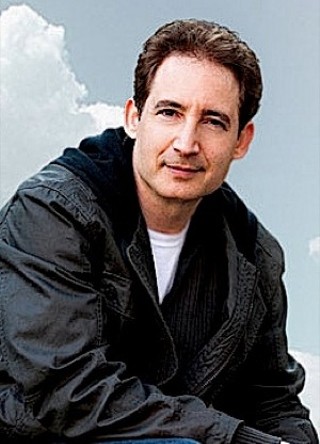Theoretical Physicist Brian Greene Has a Few New Dimensions He'd Like You to Meet
The universe-explainer brings his 'Hidden Reality' show to Austin
By Wayne Alan Brenner, 4:59PM, Wed. Jan. 16, 2013

Dr. Brian Greene isn't just a mildly popular scientist.
Greene, renowned proponent of quantum string theory and parallel universes, has fanboys and fangirls like he's some kind of Joss Whedon.
That's because the man, author of The Elegant Universe: Superstrings, Hidden Dimensions, and the Quest for the Ultimate Theory (later made into a PBS special that he hosted and narrated), talks about concepts so fantastic that only rigorous math and scholarly support keep them from slipping sideways into science fiction. That's because his live presentations (like the one at the Paramount Theatre on Thursday at 8pm) are all media-enhanced and relatively easy to parse.
"I use a variety of animated clips that we've created to help people visualize the ideas," says Greene. "So it's kind of a visual exploration – where the math is stripped away and the core ideas are captured by the imagery."
The popularity is also due to Greene being a helluva good explainer of these exotic subjects – and having an affable, easygoing personality. And, sure, he's pretty easy on the eyes, too. Has more hair than Whedon does, for instance.
Not that bald isn't sexy, too, of course.
Um, where were we again?
See? It's like some electromagnetic power of tangential concerns overwhelmed the as-yet-undeciphered force of reporterly gravity and sent us into a journalism-warping wormhole. Not even sure what that means, but we won't bother Dr. Greene about it. However, we did talk to the good doctor a couple of days ago, to ask about the whole string-theory thing in general, and we daresay it was more enjoyable than an inflatable Calabi-Yau Manifold:
Austin Chronicle: OK, I've got just a couple of questions here before we get into it so far over my head that I don't know what we're talking about at all … What is it in early childhood – or whenever it was, if there was some specific instigating event – that starts a man on a path that leads to becoming a theoretical physicist?
Brian Greene: Well, for me it's two things, and you can take your pick of which resonates. But when I was young – real young, around four or five – my dad taught me the basics of arithmetic. And I just became fascinated with numbers, that you could do things with numbers that no one had ever done before – because they thought it wasn't interesting. But it was wonderful to me, this universe of numbers. And a little later on, in high school, I learned that numbers – math – could be used to describe real stuff, not just a game, then I was really overtaken with a passion to use mathematics to try to understand the universe.
AC: And, from there, doing what you do – in addition to your research, you're now the premier explainer of this esoteric subject. You're, ah, kind of like the Carl Sagan or Neil deGrasse Tyson of string theory. And so what kind of a joy is that for you? To explain these things to people?
BG: The big joy of doing physics is the insight that it gives us into the nature of reality. And how people who don't know mathematics, who don't know physics because they haven't gone to graduate school, how these people can have whole vistas opened up by learning about what's happening on the cutting edge of research. It's thrilling to talk to people about these ideas – to kids, to adults – to those who are just curious or really want to study the subject. The whole gamut of people can get so much out of the insights that physics has revealed.
AC: And this is where my ignorance begins to make itself apparent. What meager shred that I understand of string theory – and I'm quoting from Wikipedia here – "There must be ten spatial dimensions and one dimension of time to allow for a consistently defined string theory." Unquote. Can you tell me, in layman's terms, where does this "must" come from – and can it be tested? What if reality is like, "To hell with that, I'm composed of an infinite number of dimensions and string-theory consistency can kiss my ass?"
BG: [laughs] Well, that is the most important question to ask. Because the place where that idea of extra dimensions comes from … we ordinary human beings live in a world that seems to have three dimensions in space – left, right; back, forth; and up, down – and if we throw time in there, too, as Einstein taught us we should – it gives us a total of four. But string theory, when you study the equations of string theory, the equations don't work. They fall apart if you only have three dimensions of space and one of time. But, miraculously, the equations all suddenly snap together and work really well if the universe has ten dimensions of space and one of time. But, as you're saying, that's a bizarre idea, we don't see those other dimensions, and it could be that string theory is plain wrong and the universe doesn't care about the math. And the only way to try and determine whether string theory is right and the universe really does care about it and has these other dimensions … is to do experiments which will, hopefully, be able to test these ideas. The problem, which has been an issue for string theory for twenty or thirty years now, is that the ideas of string theory only manifest themselves in a realm that we have difficulty accessing with today's technology.
AC: Because they're so small?
BG: Exactly. The ideas of string theory really come to life on extremely tiny-tiny scales – billions of times smaller than even the scale that we can reach with the Large Hadron Collider. Even that machine probably can't go small enough. So that's the quandary that we string theorists are in: We have these ideas and, mathematically, they hold together; but as of today we don't whether they're right or wrong, and it's not clear when we'll have the capacity to test these ideas.So it's a subject that's very exciting, but one that's very much in a state of … uncertainty – as to whether or not we're describing reality.
AC: But if the current technology isn't capable of testing the physical facts of these theories, how do we know that that same current technology – operating up here in the level where Einstein's general relativity seems to run the game – how do we know the current tech is accurately representing events on the quantum level in the first place?
BG: Well, we don't know that it is.
AC: Oy.
BG: The only evidence that we have is that, when we use quantum mechanics to make predictions about little particles like electrons, to provide a really good example, the truly remarkable thing is that the mathematics and the experiments that we can do on electrons, both the math and the observations agree to ten decimal places. And when you see that kind of an agreement, it kind of knocks you off your chair. And it gives you some degree of confidence that the methods you're using are heading toward truth. We then push those mathematical methods even further to hopefully reveal aspects of reality that we can't yet see.
AC: So you guys aren't using mathematics to drive the idea of how the universe is composed, you're more seeing that the math matches up at this level and therefore it should also match up at smaller levels.
BG: Precisely – that's the idea.
AC: OK. But, ah, if the theories are untestable, so far … how can they be considered any more scientific – at this point, at least – than the faith of some religion?
BG: The main difference is that our theories that we're now developing embrace theories that have been experimentally tested. So when we use string theory, within string theory is Einstein's General Theory of Relativity – which has been tested by observations of planets and stars and galaxies. And within string theory is quantum mechanics, which has been tested in understanding the properties of atoms – and particles like electrons. So these are the pillars from which string theory builds further. When you look at
AC: And say if string theory does prove to be true – in many of its aspects if not all of them – what are the possible practical applications of that? Of the whole parallel-universe idea?
BG: Well, that's a question that – my mom asks me that.
[laughter]
BG: And the first answer I'd give is: Maybe none at all. Because what we're trying to understand is the deep structure of reality – and that may not have a direct application to things in everyday life. But the absolutely vital point that I need to follow that up with is this: If you were to've asked the same question of those people developing quantum mechanics in the 1920s, "What's this gonna be good for?" They might've said more or less what I just said. "Not much. We're talking about molecules and atoms – pretty faraway from everyday life." But yet sixty, seventy, eighty years later – because of quantum mechanics – we have cell phones, we have personal computers, we have all manner of medical technology. Anything with an integrated circuit relies upon quantum physics. So it's just to say that the basic research, you may not know what it'll be good for on a practical level while you're doing it, but history seems to suggest that breakthroughs in understanding the deep structure of reality ultimately do affect the way we live our lives.
A note to readers: Bold and uncensored, The Austin Chronicle has been Austin’s independent news source for over 40 years, expressing the community’s political and environmental concerns and supporting its active cultural scene. Now more than ever, we need your support to continue supplying Austin with independent, free press. If real news is important to you, please consider making a donation of $5, $10 or whatever you can afford, to help keep our journalism on stands.
March 22, 2024
March 22, 2024
Dr. Brian Greene, Hidden Reality, quantum physics, Paramount Theatre, Joss Whedon, string-theory consistency can kiss my ass








